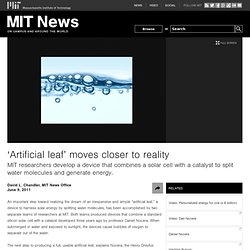

Geology. Mathematics. Biology. Swimbots. Internet, Software. New Comet Found; May Be Visible From Earth in 2013. Astronomers stumbled upon the icy interloper on June 5 while searching for potentially hazardous asteroids. Equipped with the world's largest digital camera—1,400 megapixels—the University of Hawaii's Pan-STARRS team snagged a faint image of the odd object while it was more than 700 million miles (1.1 billion kilometers) away, between the orbits of Jupiter and Saturn. ( Explore an interactive solar system. ) "Almost everything we find is an asteroid, but this object was suspicious," said Richard Wainscoat , co-discoverer of the comet and an astronomer at the University of Hawaii.
"Unlike asteroids, which appear point-like in images, the telltale sign that gave it away was its fuzzy appearance. " (Related: "Weird Asteroid Really a Crusty Old Comet? " ‘Artificial leaf’ moves closer to reality. An important step toward realizing the dream of an inexpensive and simple “artificial leaf,” a device to harness solar energy by splitting water molecules, has been accomplished by two separate teams of researchers at MIT.

Both teams produced devices that combine a standard silicon solar cell with a catalyst developed three years ago by professor Daniel Nocera. When submerged in water and exposed to sunlight, the devices cause bubbles of oxygen to separate out of the water. The next step to producing a full, usable artificial leaf, explains Nocera, the Henry Dreyfus Professor of Energy and professor of chemistry, will be to integrate the final ingredient: an additional catalyst to bubble out the water’s hydrogen atoms. In the current devices, hydrogen atoms are simply dissociated into the solution as loose protons and electrons.
If a catalyst could produce fully formed hydrogen molecules (H2), the molecules could be used to generate electricity or to make fuel for vehicles.